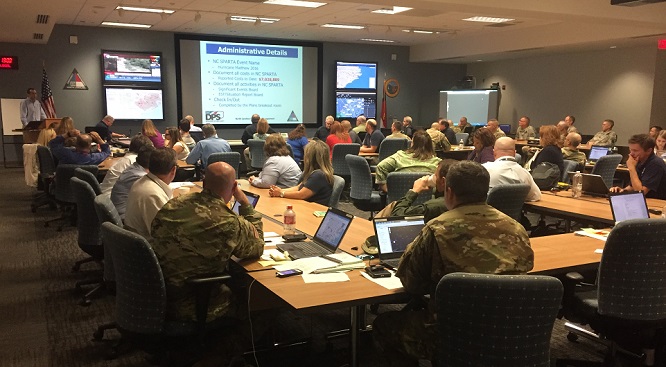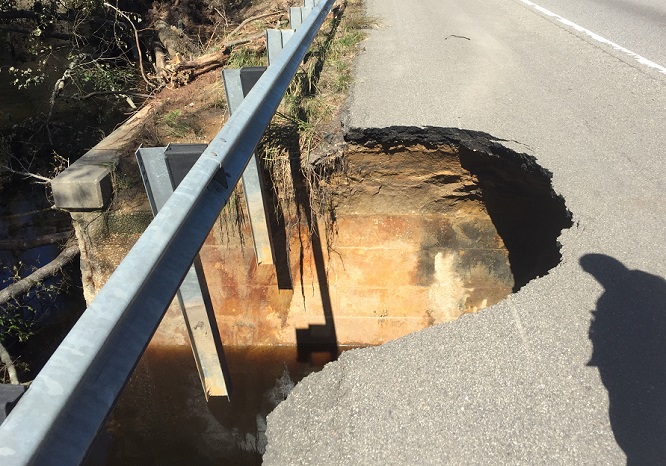Coordinating Emergency Transportation Response to Hurricane Matthew
This past fall, Category 4 Hurricane Matthew hit the Eastern Seaboard with destructive force. As it moved up from Florida through North Carolina, it was the most powerful hurricane to affect that region in over a decade and caused billions of dollars in damage.
A large team of emergency workers across multiple agencies quickly moved into action.
When disasters hit, the U.S. Department of Transportation (DOT) deploys a team of emergency transportation representatives from the National Response Program to coordinate large-scale transportation responsibilities that come with massive emergency response efforts. One of these representatives is Volpe’s Terry Sheehan. Sheehan is the Regional Emergency Transportation Representative for executing federal emergency transportation responsibilities across New England, as described in the National Response Framework, and is on call to be deployed anywhere nationally wherever a disaster hits.

A North Carolina State Emergency Operations Center (NC SEOC) team meeting about Hurricane Matthew. (Volpe photo)
Critical Situational Awareness
Name a major hurricane response and recovery effort over the past 12 years and Sheehan has likely helped coordinate transportation emergency efforts.
“I have a ‘go-kit’ with clothes, a laptop, a router, a printer, and other life sustaining items,” said Sheehan. “I am self-contained and I can just show up. Just give me a table and some place to plug in. In several previous disasters, I’ve had to work out of and sleep in my car.”
As Hurricane Matthew brought torrential rains, widespread flooding, dangerous winds, and downed power lines, Sheehan traveled to the North Carolina State Emergency Operations Center (NC SEOC) in Raleigh to begin coordinating emergency response.
Sheehan joined the NC SEOC team and immediately began identifying the status of the resources and finances available. He got to work supporting transportation capabilities that could be used to move people and goods by air, rail, and road to and from disaster-stricken areas.
“We helped identify what are the best routes, what airports are open, what temporary flight restrictions were issued, and regulatory stuff, such as motor carrier hours of service waivers, that needs to be taken care of,” Sheehan said.
A variety of emergency response teams across federal, state, local, and volunteer organizations were crucial to the emergency response effort. These included the Federal Emergency Management Agency (FEMA), Federal Motor Carrier Safety Administration (FMCSA), Federal Highway Administration, Federal Aviation Administration (FAA), Federal Transit Administration, Federal Railroad Administration, North Carolina Emergency Management Association, North Carolina DOT, and National Voluntary Organizations Assisting in Disaster (VOAD)—a collaborative coalition of nonprofit organizations that respond to disasters as part of their missions.
Emergency Response Coordination
One of the first things Sheehan helped establish was a toll-free hotline and in-person assistance.

A portion of a highway collapsed due to Hurricane Matthew. (Volpe photo)
“People could walk up to me and ask, ‘Is this road open? What’s the best route to take?’ and they’d get a real-time response,” said Sheehan. “In fact, we had an FMCSA division administrator manning the phones through Columbus Day weekend, and he helped truckers navigate flooded areas to safety, and deliver life-saving and life sustaining materials and personnel.”
Sheehan also collaborated with the NC SEOC in Raleigh, North Carolina, to notify local, state, and federal partners of emergency permitting and waiver procedures. This was essential to allow truckers and other transportation employees the resources necessary to support evacuations and shipments.
FAA, U.S. Health and Human Services (HHS), and the HHS Assistant Secretary for Preparedness and Response worked with Sheehan to coordinate air evacuations to relocate vulnerable populations, including children.
“As Hurricane Matthew disaster response progressed, we found ourselves dealing with a lot of kids—they’re not used to this,” Sheehan said. “We helped devise transportation options so that families could get out of the school shelters, go to hotels and other non-school shelter locations, and get the kids back into the classrooms. It’s about trying to get some sense of normalcy back into their lives.”
Achieving Grace
Amid the organized chaos of helping survivors rebuild their lives, get access to food and water, and move into temporary housing, Sheehan did not lose site of the big picture.
“To manage an emergency situation, you have a lot of back and forth between the DOT, FEMA, the states, and other local agencies,” Sheehan said, “but I have a more existential approach to it all, and I call it ‘grace.’ Grace, to me, is the firm and persistent belief that tomorrow is going to be a better day. You want to demonstrate to the survivors that we have ample human capital, physical resources, and effective leadership to manage and deploy these resources so that we can give survivors hope that tomorrow will be a better day.”
After the successful implementation of post-hurricane emergency management efforts, Sheehan and his team focused on laying the groundwork necessary to ensure that North Carolina continues to thrive.
“The recovery went very well. We got the critical assets in place, led a full-scale evacuation, and worked collaboratively with states and other federal agencies,” said Sheehan. “Now we’re focusing on what to do next, and it’s got to be done right. We have to figure out what we want first, and then you can send in the urban planners to make it happen.”
As emergency relief efforts evolve to meet the needs of the disaster victims, Sheehan and his go-kit are ready to meet the next challenge.
For additional information on U.S. DOT’s National Response Program, please visit https://www.transportation.gov/emergency.
